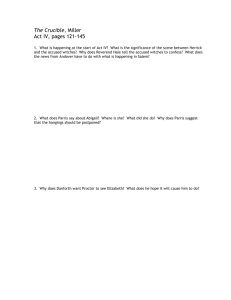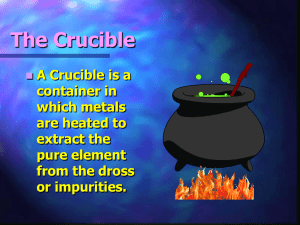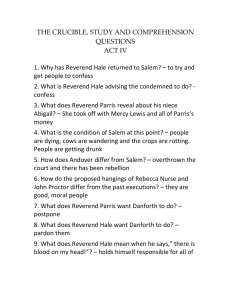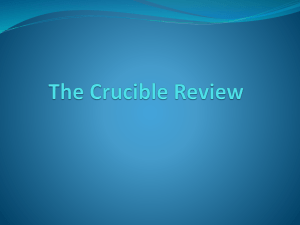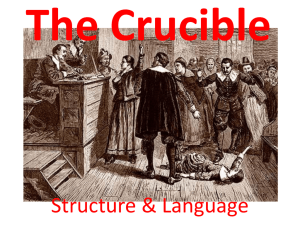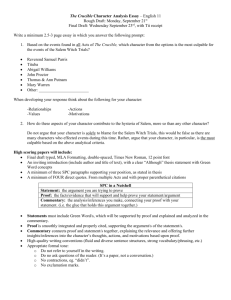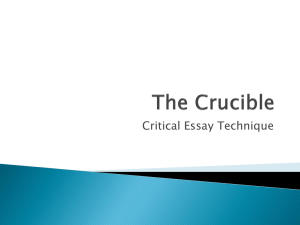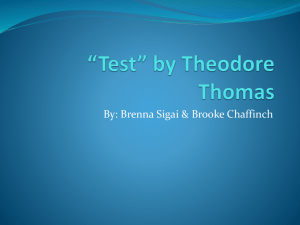Arthur Miller/Crucible Debate & Questions
advertisement
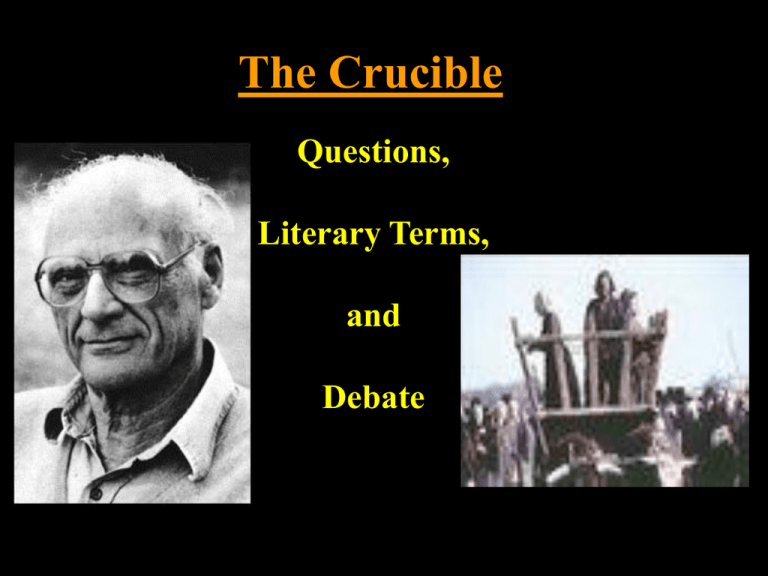
The Crucible Questions, Literary Terms, and Debate What is a crucible? What were the Salem Witch Trials? Who were the Puritans? Why the name Puritan? What type of government existed in Colonial New England? What was the relationship between church and state in Colonial New England? Today? What is slavery? What is witchcraft? Literary Terms: Historical Fiction Protagonist: usually a real person or based on a real person, heroic, reveals plot, high interest character Theme: generalization about life addressing social, political, religious, economic… issues. Plot: revolves around a historical event, usually accurate, reveals the history and personalities of the times Antagonist: rival to the hero / heroine Point of View: protagonist, third person Voice: author’s or sometimes protagonist How do the following play a role? - human cruelty for righteousness - Individual vs. Community - Justice vs. Revenge - Godliness vs. Worldliness - Ignorance vs. Wisdom - Puritan Myth - Order vs. Individualism (freedom) Play Structure: - Acts and scenes - Stage directions in italics - Rising action and falling action - Climax Irony: instances in which the intended meaning of a word or phrase used is opposite of what it actually means Allegory: a story in which people, things, and happenings have another meaning. (Political Allegory) Paradox: a statement or event contrary to what one might expect. Act 1: Get into small groups and using a graphic organizer, outline, or chart create a short presentation on the following assigned characters: John Proctor Reverend Hale Reverend Parris Mrs. Putnam Giles Corey The girls Abigail, the girls, John Proctor Your presentation will present a list of human ‘qualities’ and examples from the play supporting these ‘qualities’. Who is the voice of reason? Provide specific examples of how the character is the voice of reason. You and your group members will need to identify the themes presented in Act 1. Locate and explain where, when, and how the themes are presented. What are the six items in the plot diagram? Plot is developed through conflict. Identify and explain the conflicts that are presented in Act 1. How are the following examples of irony? - “I’d almost forgot how strong you are, John Proctor!” - “I never knew the lying lessons I was taught by all of these Christian women and their covenanted men!” - “The marks of his presence are definite as stone.” How is color used in the play? (white, black, blush) How are the gender pronouns used in the play? Why the title, The Crucible? ACT 2 Explain the relationship between John and Elizabeth Proctor. What role does Mary Warren play during the trial? How do you see Reverend Hale? Trace his opinions about witchcraft, his abilities, his belief about the role of the church and his beliefs about the court system. Identify and explain the changing roles Mary Warren goes through. Who is the voice of reason in Act 2? How is the theme human cruelty and righteousness presented in this Act? Research: What is “Malleus Maleficorum”? What was “Wonders of the Invisible World” by Cotton Mather’s report? What is figurative language? What is a metaphor? Explain these: “your justice would freeze beer”, “the man dreams cathedrals, not clapboard meeting houses”, “theology…is a fortress” For discussion: What does an individual’s ability to use figurative language tell you about that person? Which characters in the play tend to use metaphors often? ACT 3 Explain how revenge, justice, ignorance, and wisdom are used? Support with quotations. Which characters favor ignorance? Why? Research: Examine the idea of separation of church and state. (who, what, when, and why) Locate any recent court cases that address this concept. What are the major turning points in the play? How is Act 3 the climax? How is John Proctor the voice of reason? In small groups discuss and prepare a debate for the motivations and actions of the following characters: Danforth Abigail Mary Warren ACT 4 Community: Who is a part of the Salem Community? Who is excluded? How and why does the trial change the order of Salem? What happens to the community when the order is changed? Order vs. Freedom: Why did the Puritans come to America? What individual freedom was present in Salem? What level of order? What happens when the balance is offset? When does order become autocratic? Why does Miller end the play with Proctor’s refusal to sign the confession and Elizabeth’s refusal to beg him to sign? Why does Hale want him sign? Why does Danforth want Proctor to see Elizabeth? After thoughts: What is theocracy and how was it broken? Were the events in Salem important in the development in democracy in America? Was Salem an autocracy? Who was the leader? What is a tragedy? Was this play a tragedy? Who is the tragic hero? Who has the tragic flaw? What moral weaknesses are present? Psychological? Social Pressures? Each character has his own distinct quality. Most characters are distinctly good or evil. Example: In the play, farmer John Proctor is accused of witchcraft. He takes the occasion to examine himself and acknowledge his faults, unlike his accusers. He also withstands the attempts by prosecutor Danforth to exploit him, and refusing to sign a false confession he is hanged. His death affirms the values by which he stood, not the values of the time that condemned him. Themes: •Pride - John refusal to sign the confession because he would loose his pride and good name. •Revenge - The girls and the accusers were naming people whom they did not like and wanted to harm them. •Fear - Fear of the devil permitted the witch trials. •Conflict of authority - Danforth felt the law should be followed exactly, and that anyone who opposed the trials was trying to undermine him and his authority and the church. •Puritan Ethics - They believed lying and adultery were horrible sins. •Self interest - They were looking out for their own lives and took whatever actions necessary to save themselves. •Honesty- Elizabeth Key issues: Fear, self interest: Shows what happens when emotions control your logic and thinking. Hysteria vs. selfpreservation. Puritan Ethics: Church was very important. Very religious Modern things destroying the old church. Believed in the devil and pacts with him. It was a horrible sin to lie. Integrity: John broke the trust between Elizabeth and him. He sinned, and the people would have condemned him, if they knew. EXAMPLE CRITICISM QUESTIONS Characters: Are the characters fully developed? Is the reader is only able to see one side of each character? Is John Proctor, the main character as developed as he could be? Is this due to the restrictions of time and narration of this particular genre? Setting: Why Salem, Massachusetts during the 17 century? Is the setting real? Why? How? Is it important that the story takes place during the 17 century? Why choose this community? Why this group of people? Why not use the twentieth and even the nineteenth centuries? Plot Do the events flow naturally? Does the story factual basis make it more interesting? Are the results believable? Was there sufficient conflict to keep my interest? Is this historical fiction? What events in Salem can be seen as a paradox? Is this play political allegory? How does the play specifically show irony? Does the title The Crucible work? Be able to identify characters, plot, themes, and connections to areas outside of the play.
